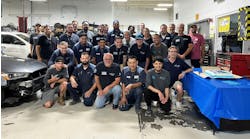A Tax Credit In 2006
WASHINGTON - The recently passed Energy Bill will change the amount of tax deductions for eligible fuel efficient vehicles - such as hybrids, clean diesel, and hydrogen powered vehicles - beginning with purchases after Jan. 1, 2006. The measure expires Dec. 31, 2010.
The change in application will affect both the amount of the tax deduction, and it will reward vehicles with highest fuel efficiency. Rather than be tied to the buyers tax bracket, the deduction will now be a credit that is based on the fuel efficiency and weight of the vehicle, not the purchaser's income. As well, only the first 60,000 vehicles sold by an automaker during the time period will have the full credit. After that, the tax credit will decline to zero over the following 18 months.
Eligible vehicles must have met the Environmental Protection Agency's Tier II Bin 5 vehicle emissions standard. Currently only hybrids have done so. Although no diesel-powered vehicle has qualified, the integration of clean diesel technology (advanced particle filters, ultra low sulfur content, etc.) in upcoming 2007 models may enable some to qualify.
(Sources: U.S. Department of Energy, USAToday, Turbotax)
EPA Updates Vehicle Diagnostic Systems, Evaporative Emissions RulesWASHINGTON - The Environmental Protection Agency (EPA) finalized a pair of rules designed to clarify and update its existing vehicle On-Board Diagnostic (OBD) program and amend provisions of its evaporative emission regulations.
The OBD clarifications will allow manufacturers of passenger vehicles, trucks and heavy-duty engines to choose one OBD system to satisfy federal and California state requirements. OBD systems detect excess emissions and potential vehicle repair needs and provide drivers with an early warning light when these situations arise.
EPA also finalized amendments to provisions of its evaporative emissions regulations. EPA's evaporative emissions regulations detail the testing process motor vehicle manufacturers must follow to obtain emissions certification as required in the Clean Air Act. An evaporative emissions test detects the amount of hydrocarbon pollution that results when liquid fuel molecules evaporate and escape into the atmosphere.
The two amendments will streamline the evaporative emissions test procedures for cars, trucks, pickups, minivans, SUVs and larger trucks up to 14,000 pounds, and they will harmonize federal and California evaporative emissions test procedures, says the Agency. In addition, the amendments will allow vehicle manufacturers and EPA to use more advanced testing equipment to test four-wheel-drive and all-wheel-drive vehicles.
(Source: EPA)
M-B Improves Vehicle Fluid Extraction And RecyclingSTUTTGART, GERMANY - The Mercedes-Benz (M-B) UsedParts Center has put into operation a new, more efficient facility for the extraction of service fluids from end-of-life vehicles. Thanks to a new environmentally compatible technology, the proportion of fluids removed has now risen to as much as 98 percent, the automaker announced.
This new facility provides quicker and more efficient removal of the numerous service fluids used in vehicles. Fluids such as refrigerants or windshield fluid can now be extracted from the upper section of the vehicle at the same time oil or fuel is drained from under the vehicle. M-B estimates it has increased the number of vehicles processed per day by more than 60 percent.
The system is designed as a double unit; the two parts also can function independently of one another, thereby ensuring continuity in the case of a malfunction. Newly designed pressure systems attain a much higher drainage rate in extracting brake fluid or coolant than the systems used to date, which relied entirely on suction. Also incorporated is a movable carrier unit that can tilt the vehicle to ensure extraction from the lowest point in the tank. M-B reports that two to three liters more fuel can be removed by this means.
The automaker says that it has incorporated a quality control system to ensure clean and contaminated fluids are collected separately. Following extraction, the various service fluids are reprocessed and reused in order to preserve natural resources and the environment. Besides technical improvements, worker safety has been addressed - the collecting pan under the unit is fitted with a non-slip surface, and the risk of tripping has been reduced with the elimination of hanging hoses.
Once fluids have been drained, vehicles are dismantled. Reusable components such as sheet-metal panels, engines, transmissions, axles, wheels and tires, interior appointment parts or audio products are stored and resold as used parts with a 12-month warranty. The residual vehicle carcass is then compressed and disposed of in compliance with the appropriate environmental directives.
(Source: Mercedes-Benz)
Technology Tracks Hose MaintenanceAKRON, OH - To help industrial hose end-users, Goodyear Engineered Products is introducing an on-line tracking system that takes the guesswork out of hose maintenance.
Hose Trakker Online monitors hose assemblies from pre-installation through the life of the product. The Web-based tool is available only to Goodyear Star distributors and allows their customers to access hose assembly records, while sharing information with a click of a mouse. According to Keith Collett, Goodyear's industrial hose marketing manager, the tracking tool monitors inventories, product location, maintenance schedules and test history of industrial hose assemblies.
Jointly developed with Canadian-based InfoChip Systems Inc., the system initially uses serial tags installed by Star distributors that identify hose assemblies. Next-generation hoses will use radio frequency identification (RFID) microchips that uniquely identify the product and further simplify the identification and tracking process, adds Goodyear.
"The service provides Goodyear Star distributors and end-users with an innovative tool in an industry where performance and maintenance are critical," said Collett. Goodyear's Star network includes 45 hose distributors in North America that make up more than 500 selling locations and 100 assembly operations. Goodyear adds that each distributor has been independently verified by Underwriters Laboratories Inc. for meeting hose assembly standards established by the National Association for Hose and Accessories Distribution.
(Source: Goodyear Tire & Rubber Co.)
UK Survey Laments Legislative Cost Burden, But Praises EducationLONDON - The United Kingdom's automotive industry is positive about future prospects, but the cost burden of new legislation continues to blight competitiveness. That's the central theme to emerge from the Society of Motor Manufacturers and Traders Ltd. (SMMT) annual industry survey, "Automotive Manufacturing 2005." Looking at the report, readers can see certain parallels with the automotive industry here in the United States, as well as see possible indicators for the future on issues such as government regulation.
The report reflects the views of executives from companies in the UK automotive sector from component and aftermarket suppliers to car and commercial vehicle manufacturers. While productivity is improving and initiatives to address the skills gap are starting to bear fruit, the industry has called for action to limit the legislative cost burden. Furthermore, the sector remains critical about transport infrastructure and has called for more support from government for international trade.
SMMT President Roger Putnam commented about the strength of feeling within the industry regarding the cost burden of new and sometimes conflicting legislation: "Europe already has the most stringent and costly regulations worldwide. This central concern is one reflected across Europe, but my hope is that it may subside in years to come.
"The CARS21 initiative has an agenda to work towards better regulation, a coherent 10-year roadmap for the industry and an integrated approach to both the environment and safety agendas. Its work will be critical to the future of the automotive sector in the UK," Putnam added.
Key report findings reveal that:
* 84 percent of those surveyed said that prospects of growth over the next five years are good, compared to 81 percent last year and 75 percent in 2003.
* 95 percent of those surveyed say that the burden of legislation has significantly increased costs in the last five years, and 93 percent believe the situation will worsen in the next five.
* 36 percent of respondents indicate that simplifying the regulatory environment was the single biggest thing the government could do to support the automotive industry.
* 78 percent of those surveyed cited infrastructure as making it difficult for UK companies to remain competitive, while 87 percent believe it will not improve in the next five years.
* 53 percent responded that British competitiveness will improve over five years compared to mainland Europe, but this figure falls to 30 percent when compared with the United States and just 4 percent in relation to companies operating in the Asia-Pacific region.
* 48 percent of those surveyed say that it is hard to recruit appropriately skilled employees. However, this is an improvement from 65 percent last year. Level 3 skills, the highest level of certification, remain the greatest headache for employers. Nevertheless, in three years, the proportion of respondents citing it as the most difficult area to recruit has fallen from 46 to 29 percent.
* From an education and training perspective, 89 percent said the efforts of the Automotive Academy in closing the skill gap have been effective. Two-thirds of companies believe the institution will impact their business.
The full report can be viewed at SMMT's Web site.
(Source: SMMT)
Why Aren't There More 40+ MPG Vehicles Here?WASHINGTON - Ever heard of the Ford Fiesta that gets 45 mpg in the city and 60 mpg on the highway? Not familiar with the Volkswagen Lupo with a combined city/highway rating of 53.5 mpg? Don't remember a car salesman ever offering you a test drive in a GM Opel/Vauxhall Tigra that does better than 60 mpg on the open road? Never been passed by the sleek BMW 5 Series Saloon that gets 50 mpg on the highway?
You are far from alone. According to new research released by the non-partisan, non-profit Civil Society Institute (CSI) think tank, these are just a few of the 86 models that get a combined rating of 40 mpg or better, but are not sold in the United States, where only five cars are rated as highly by the U.S. Environmental Protection Agency (EPA). In addition, says CSI, 51 of these foreign, fuel-efficient vehicles are either made by U.S. manufacturers or foreign automakers with extensive U.S. sales operations. Interestingly, most of these vehicles are clean-diesel powered and not hybrids.
This situation does not sit well with millions of frustrated American consumers who face both high gas prices and often lengthy delays when trying to buy more fuel-efficient vehicles in the United States. Nine out of 10 Americans (88 percent) say that "U.S. consumers should be able to get the best of the more fuel-efficient vehicles that already are available in other countries," according to a new Opinion Research Corporation (ORC) national opinion poll conducted for CSI and 40mpg.org, which has a margin of error of +/- 3 percent.
"This survey and our related research on the ready availability of more fuel-efficient vehicles overseas shows that the emperor truly has no clothes when it comes to a federal 40 mpg fuel efficiency standard," said CSI President Pam Solo. "Those who claim that the technology doesn't exist are wrong. They are just as off-base when they say that consumers don't want these smaller, more fuel-efficient cars. There is a reason why U.S. automakers are laying off people in the tens of thousands and steadily losing ground to foreign competitors."
She added, "The industry is not listening to consumer demand. And the more consumers make the connection between America's dependence on Middle Eastern oil, the connection to global warming and so on, the more the pressure for change will build. The availability of fuel-efficient vehicles in Europe demonstrates clearly that consumer demand and national policies can make an industry respond."
Other key CSI survey findings included:
* 70 percent of Americans want to see higher federal fuel efficiency standards for vehicles in order to cut Middle Eastern fuel use and to combat global warming.
* 82 percent say the United States hasn't done enough to conserve energy through such steps as requiring higher federal fuel efficiency standards for vehicles.
* 57 percent think a windfall profits tax should be imposed despite recent testimony before Congress by oil company executives who denied any role in price gouging at the gas pump.
* 57 percent favor alternative energy development over subsidies for winter heating bills, as the best use of oil windfall profit tax revenues, if imposed.
"The benefits of making 40 miles per gallon the standard for all autos in the United States are obvious to Americans," said Solo, citing the survey's results as evidence for her statement.. "Greater fuel efficiency makes sense, it is technologically possible, the benefits are real and the challenges can be overcome."
More information, including a list of vehicles, is available online at http://www.resultsforamerica.org/index.php.
(Source: Civil Society Institute)
Consumers Race To Yellow Pages When Seeking Repair ServicesBERKELEY HEIGHTS, NJ - Whether seeking an oil change, new brakes or a new car, Americans consistently turn to their "Yellow Pages" in search of automotive services, according to the Yellow Pages Association (YPA). The association says conducting more than 1 billion look-ups per year.
According to the Yellow Pages Association (YPA), the Automobile Parts-New & Used, Automobile Repairing & Service and Automobile Dealers-New & Used Yellow Pages headings rank third, fourth and seventh respectively out of more than 4,000 headings searched by consumers. The top 12 most frequently referenced headings are Restaurants, Physicians-Surgeons, Automobile Parts, Automobile Repairing-Service, Pizza, Attorneys-Lawyers, Automobile Dealers, Dentists, Hospitals, Beauty Salons, Plumbing Contractors and Insurance.
"For the first time ever there are more registered vehicles than licensed drivers in the U.S., and that means every day hundreds of thousands of consumers are looking for auto parts stores and repair shops to service and repair their passenger car, pick-up truck, SUV or minivan," said Rich White, executive director of the Car Care Council. "The aftermarket - automotive service, parts, accessories and repair - account for nearly $200 billion a year."
(Source: Yellow Pages Association)


